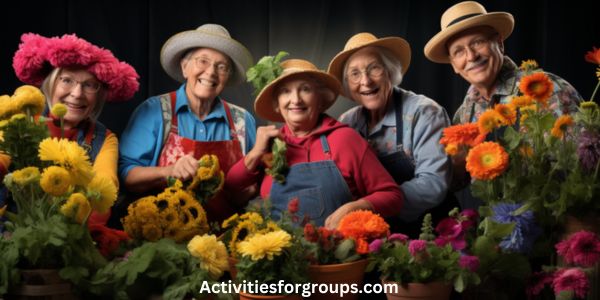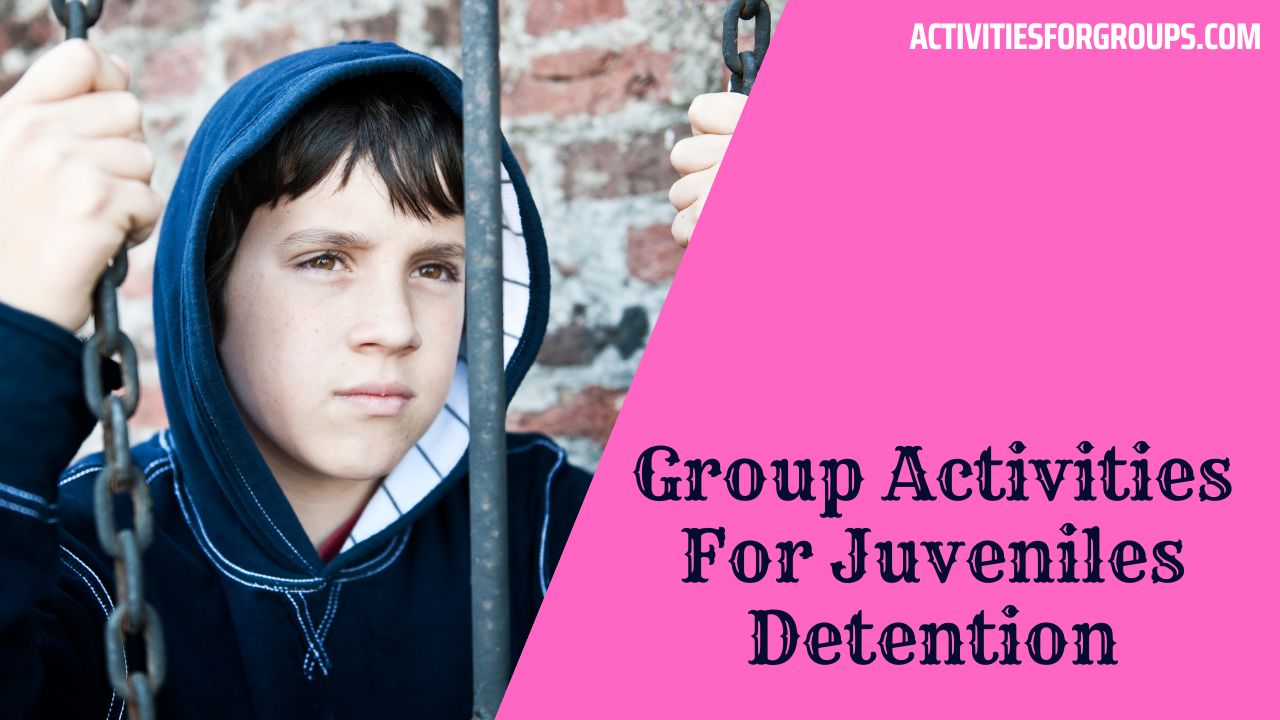Gardening is a great way for seniors to stay active and enjoy the outdoors.
But why not take it a step further and join a group gardening project?

Get the complete guide here and learn how to get started, select the right plants, and manage resources for a successful project.
Plus, discover the long-term benefits of these projects for seniors!
Benefits of Group Gardening Projects for Seniors
Your seniors’ group gardening projects can bring many benefits. Socializing with others and being a part of a shared activity gives seniors a sense of belonging and purpose. Working together on a project can increase their sense of contribution and self-worth.
Gardening can also be a great source of exercise, as it can be done in a light-intensity way to increase flexibility, strength, and balance. Physical activity can help improve mental and emotional health, as well as reduce the risk of depression and anxiety.
Gardening also provides an opportunity for seniors to learn new skills and knowledge. From understanding the science of how plants grow to learning how to build and maintain a garden, seniors can gain a sense of accomplishment from mastering new tasks.
Additionally, working on a group project can help foster relationships and friendships among the seniors, as they work together to bring their garden vision to life.
Gardening also provides a great way to engage the senses. Smelling the fragrances of flowers and herbs, feeling the warmth of the sun, and hearing the buzzing of bees can be extremely calming and therapeutic.
Group gardening projects can also offer a chance to appreciate the beauty of nature and create a place of solace and peace away from the hustle and bustle of daily life.
Getting Started With a Group Gardening Project
You’ll want to get started on your group gardening project by first determining the size and scope of the project. Consider the amount of time, money, and effort that can be put into the project. Decide if it will be a small project that takes a few hours a week or a large project that will need more resources and time. You’ll also need to decide who’ll be involved in the project. Will it be a group of seniors who all have a common interest in gardening? Or will it be a group of volunteers from the community who’ll help out?
Once you have determined these details, it’s time to create a plan of action. What plants will be grown? What tools and supplies will be needed? What tasks will need to be done each week? Write everything down so that everyone involved knows what needs to be done.
Be sure to involve everyone in the planning process. Ask each member of the group what tasks they’d like to do and what ideas they’ve for the project. This will help ensure that everyone is on the same page and that everyone feels like they’re contributing to the project.
Finally, make sure that everyone involved knows the rules and safety protocols for the project. Be sure to discuss proper safety protocols such as wearing gloves, using tools correctly, and avoiding contact with any potentially dangerous plants.
With a good plan and safety protocols in place, your group gardening project can be a fun and rewarding experience.
Tips for Successful Group Gardening Projects
Planning the logistics of a group gardening project can be a daunting task. However, with the right preparation and maintenance, it can be a rewarding experience for everyone involved.
Let’s explore the tips and tricks to make sure your group gardening project is a success!
Planning Logistics
How can you ensure a successful group gardening project for seniors? To begin, it’s important to plan ahead and anticipate the needs of the group. Here are four tips to help you get started:
- Choose a site that’s suitable for the activity; consider access to sun, water and space for wheelchairs or walkers.
- Create a schedule that works for everyone and set realistic goals.
- Secure the appropriate tools and supplies in advance.
- Make sure to have enough volunteers to help with the project.
With careful planning and attention to detail, you can ensure that your group gardening project is a success!
Garden Maintenance
Maintaining your group garden is key for successful projects, so be sure to keep up with regular maintenance. Watering and weeding are the most important tasks, but also consider other tasks such as pruning, fertilizing, and pest control.
| Task | Frequency |
|---|---|
| Watering | Daily |
| Weeding | Weekly |
| Pruning | Monthly |
| Fertilizing | Quarterly |
| Pest Control | As needed |
Start by creating a schedule and assigning tasks to volunteers. Have a designated leader in charge of scheduling and keeping everyone accountable for their tasks. Monitor plants for signs of disease or pests and take swift action if needed. With everyone’s help, your garden can remain healthy and thriving!
Finding the Right Space for the Project

When planning a group gardening project for seniors, it’s important to take into account the location and size of the project.
Finding the right space can be the make-or-break factor in the success of the project, so make sure to take the time to do it right!
Location Considerations
Finding the right space for your group gardening project is key to its success. When selecting a location, consider factors such as:
- Accessibility – Is the space easily accessible for seniors with limited mobility?
- Sunlight – Does the area get enough sunlight for the plants you plan to grow?
- Size – Is the space large enough to accommodate all the plants and the gardeners?
- Amenities – Is there access to water, compost, and other gardening supplies?
Take into account the climate of the area too. If the weather is too wet or too dry, your plants may not thrive. Also, make sure the ground is suitable for gardening. Test the soil for nutrients, pH levels, and organic matter.
Finally, it’s important to think about the potential safety concerns of the space. Make sure the area is well lit and free of sharp objects or hazards.
With the right space, your group gardening project can be a success.
Size Requirements
Deciding on the right size space for your project is essential, and you’ll need to consider a few factors. Size, access to sunlight, and available resources will all play a part in choosing the right location.
For a group project, the size should be large enough to accommodate all your materials and resources, while still allowing enough room for everyone to work comfortably.
| Factor | Considerations |
|---|---|
| Size | How much space is available? Is it big enough for everyone to work comfortably? |
| Sunlight | Is the area in direct sunlight or shaded? |
| Resources | Are there access to water, electricity, and other tools? |
Choosing the Right Plants
You’ll want to choose the right plants for your group gardening project. Before making your selections, consider the environment, climate, and available resources.
- Decide if you want to plant annuals, perennials, or herbs.
- Identify the soil type, pH levels, and light exposure.
- Choose plants that will thrive in the given conditions.
- Pick varieties that are easy to maintain and care for.
When selecting plants, research which species are best suited for your project. Consider the ease of growing and maintenance, as well as the blooming size and colors. If you’re gardening with seniors, you may also want to pick varieties that are safe for them to handle.
Take into account the amount of time and effort each plant requires. With group gardening projects, it’s important to opt for low-maintenance varieties that don’t require extensive upkeep. You also want to make sure the plants you choose are resistant to common diseases and pests.
Finally, look for plants that will benefit the environment and attract beneficial insects such as bees and butterflies. Not only will this add more life to your garden, but it will also help support the local ecosystem.
When done correctly, choosing the right plants for your group gardening project can bring years of enjoyment and satisfaction. With the right selections, you can create a beautiful and inspiring space that will bring joy to everyone involved.
Encouraging Participation in the Project

Encouraging your senior group to participate in the gardening project is key to its success. A great way to get everyone involved is to make it fun and inviting. Start by creating a warm and welcoming atmosphere where members feel comfortable. Make sure to explain the benefits of the project in detail and provide helpful tips that make it easier for seniors to participate.
In addition, offer incentives to encourage seniors to get involved. This could be in the form of prizes or discounts for those who contribute. You could also give out small rewards for reaching certain milestones or for completing a certain amount of work.
Another way to get seniors engaged is to break the project down into smaller tasks. This will help keep everyone motivated and make it easier for them to contribute. It can also help to assign tasks to individuals or small groups so that everyone feels like they’re contributing.
Finally, make sure to recognize each person’s contribution. Acknowledge and thank everyone for their hard work, and celebrate their accomplishments. This will help to keep everyone motivated and engaged.
With a little effort and creativity, you can make your gardening project for seniors both fun and rewarding. By focusing on engagement and recognition, you can ensure that everyone in your group is fully invested in the project and eager to contribute.
Managing Resources for the Project
Efficiently managing resources for the project is essential for its success. Here are four key steps to ensure that the resources are managed properly:
- Create a budget for the project and stick to it. Make sure to account for the cost of materials, tools, and labor.
- Delegate tasks to members of the group to ensure that all of the necessary work is being done.
- Seek out donations from local businesses or organizations to help offset the costs.
- Monitor the progress of the project regularly to ensure that resources are being used effectively.
By following these steps, you can ensure that the resources are managed properly and that the project is completed on time and on budget.
Working together as a group, you can create a beautiful garden that will bring joy to you and your community.
Maintaining the Project for the Long-Term
Once the project is complete, you’ll need to maintain it for the long-term. Regular upkeep is essential for keeping the garden looking good and producing healthy plants and vegetables. In order to maintain the garden for the long-term, you should follow a few simple steps.
| Activity | Frequency |
|---|---|
| Watering | Daily |
| Weeding | Weekly |
| Fertilizing | Monthly |
| Pruning | As Needed |
Watering is important to keep the soil moist and to prevent the plants from drying out. Make sure to check the soil moisture daily and water as needed. Weeds can quickly take over a garden, so it’s important to check weekly for any weeds and remove them as soon as possible. Fertilizing your garden once a month will help keep the plants healthy and provide the nutrients they need for growth. Pruning is also essential for keeping the plants looking neat and tidy. Pruning should be done when needed, usually after a period of growth or when the plants become overgrown.
Frequently Asked Questions [FAQs]
How Much Time Do Group Gardening Projects for Seniors Typically Take?
How much time do gardening projects take? It depends on the scope, but generally it’s a few hours each week. You’ll need to factor in time for planning, shopping, and upkeep.
What Is the Best Way to Keep Seniors Safe While Working on a Group Gardening Project?
Make sure seniors wear protective gear and stay hydrated while working on the project. Offer breaks throughout the day and ensure the environment is well-lit and clear of debris.
How Can Group Gardening Projects for Seniors Be Adapted to Suit Different Levels of Physical Ability?
Adapt the project to match the abilities of each senior. Let them decide what tasks they’re able to do and provide support for those who need it.
Are There Any Grants Available to Help Fund Group Gardening Projects for Seniors?
Are you looking for grants to fund a gardening project? Check with local nonprofits, civic organizations, and government programs for available funding.
What Kind of Tools Are Needed for a Successful Group Gardening Project?
You’ll need basic gardening tools like trowels, shovels, hoes, and rakes to get started. Don’t forget gloves, wheelbarrows, and pruners, too!
Conclusion
Gardening projects for seniors are a great way to bring the community together and provide seniors with an opportunity to get outdoors and enjoy the fresh air.
create a successful group gardening projecton, you can create a successful group gardening project that will benefit seniors for years to come.
From finding the right space to encouraging participation, you can ensure the project is successful and enjoyable for all involved.




Leave a Reply